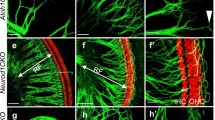Abstract
Analyses of single and double mutants of members of the neurotrophin family and their receptors are reviewed. These data demonstrate that the two neurotrophins, brain-derived neurotrophic factor (BDNF) and neurotrophin 3 (NT-3), and their high-affinity receptors trkB and trkC, are the sole support for the developing afferent innervation of the ear. Neurotrophins are first expressed in the otocyst around the time afferent sensory neurons become postmitotic. They are crucial for the survival of certain topologically distinct populations of sensory neurons. BDNF supports all sensory neurons to the semicircular canals, most sensory neurons to the saccule and utricle, and many sensory neurons to the apex and middle turn of the cochlea. In contrast, NT-3 supports few sensory neurons to the utricle and saccule, all sensory neurons to the basal turn of the cochlea and most sensory neurons to the middle and apical turn. Some topologically restricted effects reflect the pattern of neurotrophin distribution as revealed by in situ hybridization (e.g., loss of all innervation to the semicircular canal sensory epithelia in BDNF or trkB mutants). However, other topologically restricted effects cannot be explained on the basis of current knowledge of neurotrophin or neurotrophin receptor distribution. Data on mutants also support the notion that BDNF may play a role in neonatal plastic reorganization of the pattern of innervation in the ear and possibly the brainstem. In contrast, data obtained thus far on the ability of neurotrophins to rescue adult sensory neuron after insults to cochlear hair cells are less compelling. The ear is a model system to test the interactions of the two neurotrophins, BDNF and NT-3, with their two high-affinity receptors, trkB and trkC.
Similar content being viewed by others
Author information
Authors and Affiliations
Additional information
Received: 28 August 1998 / Accepted: 20 October 1998
Rights and permissions
About this article
Cite this article
Fritzsch, B., Pirvola, U. & Ylikoski, J. Making and breaking the innervation of the ear: neurotrophic support during ear development and its clinical implications. Cell Tissue Res 295, 369–382 (1999). https://doi.org/10.1007/s004410051244
Issue Date:
DOI: https://doi.org/10.1007/s004410051244




